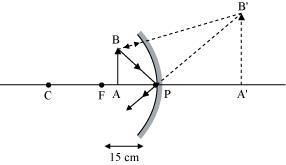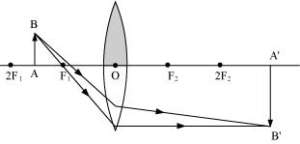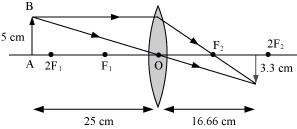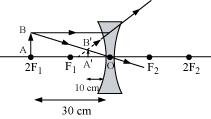NCERT Solutions Class 10 Science
The NCERT Solutions in English Language for Class 10 Science Chapter – 10 (Light Reflection and Refraction) have been provided here to help the students solve the questions from this exercise.
Chapter – 10 (Light Reflection and Refraction)
Questions
1. Define the principal focus of a concave mirror.
Answer – A point on the principal axis where the parallel rays of light after reflecting from a concave mirror meet.
2. The radius of curvature of a spherical mirror is 20 cm. What is focal length ?
Answer – Radius of curvature, R= 20 cm.
Radius of curvature of a spherical mirror = 2 × Focal length (f)
R = 2f
20 = 2f
f = 20/2
f = 10 cm
3. Name a mirror that can give an erect and magnified image of an object.
Answer – A concave mirror.
4. Why do we prefer a convex mirror as a rear-view mirror in vehicles ?
Answer – This is because a convex mirror forms an erect and diminished (small in size) images of the objects behind the vehicle and hence the field of view behind the vehicle is increased.
Questions
1. Find the focal length of a convex mirror whose radius of curvature is 32 cm.
Answer – R = +32 cm.
Therefore, f = R/2 = +32/2 = +16 cm.
Thus, focal length of the convex mirror = +16 cm.
2. A concave mirror produces three times magnified (enlarged) real image of an object placed at 10 cm in front of it. Where is the image located ?
Answer – Distance of object from concave mirror (u)= -10 cm.
Magnification (m) = -3
m = -v/u
v = -mu = -(3) × (-10)
v = -30 cm.
Thus, the image is located at a distance of 30 cm to the left side of the concave mirror.
Questions
1. A ray of light travelling in air enters obliquely into water. Does the light ray bend towards the normal or away from the normal ? Why ?
Answer – The ray of light bends towards the normal because the speed of light decreases when it goes from air (rarer medium) into water (denser medium).
2. Light enters from air to glass having refractive index 1.50. What is the speed of light in the glass ? The speed of light in vacuum is 3 × 108 m s-1
Answer – Speed of light in vacuum (c) = 3 × 108 m/s.
Refractive index = c/v.
Speed of light in glass = 3 × 108 m/s / 1.50
= 2 × 108 m/s
3. Find out, from Table (10.3), the medium having highest optical density. Also, find the medium with lowest optical density.
Answer – Table (10.3)
|
Material medium |
Refractive index |
Material medium |
Refractive index |
|
Air |
1.0003 |
Canada Balsam |
1.53 |
|
Ice |
1.31 |
– |
– |
|
Water |
1.33 |
Rock salt |
1.54 |
|
Alcohol |
1.36 |
– |
– |
|
Kerosene |
1.44 |
Carbon disulphide |
1.63 |
|
Fused quartz |
1.46 |
Dense flint glass |
1.65 |
|
Turpentine oil |
1.47 |
Ruby |
1.71 |
|
Benzene |
1.50 |
Sapphire |
1.77 |
|
Crown glass |
1.52 |
Diamond |
2.42 |
As per table, diamond has highest optical density (2.42). Medium with lowest optical density is air (1.0003)
4. You are given kerosene, turpentine and water. In which of these does the light travel fastest? Use the information given in table 10.3
Answer – Table (10.3)
|
Material medium |
Refractive index |
Material medium |
Refractive index |
|
Air |
1.0003 |
Canada Balsam |
1.53 |
|
Ice |
1.31 |
– |
– |
|
Water |
1.33 |
Rock salt |
1.54 |
|
Alcohol |
1.36 |
– |
– |
|
Kerosene |
1.44 |
Carbon disulphide |
1.63 |
|
Fused quartz |
1.46 |
Dense flint glass |
1.65 |
|
Turpentine oil |
1.47 |
Ruby |
1.71 |
|
Benzene |
1.50 |
Sapphire |
1.77 |
|
Crown glass |
1.52 |
Diamond |
2.42 |
As the refractive index of water is least out of three substances, hence speed of light is maximum in water. So, light travels fastest in water.
Questions
1. Define 1 dioptre of power of a lens.
Answer – One dioptre of is defined as the power of lens having a focal length of 1 m.
2. A convex lens forms a real and inverted image of a needle at a distance of 50 cm from it. Where is the needle placed in front of the convex lens if the image is equal to the size of the object ? Also, find the power of the lens.
Answer –
Image distance (v) = +50 cm,
hi = ho
hi/ho = v/u
u = v × ho / hi
= 50 × ho / hi
= 50 cm.
Now,
u = -50 cm
v = + 50 cm.
f = ?
1/f = 1/v – 1/u
1/f = 1/50 + 1/50
f = + 25 cm. = 0.25 m
Power of lens (P) = 1/f
= 1/ 0.25 = + 4D.
3. Find the power of concave lens of focal length 2m?
Answer – Focal length of concave lens = – 2 m.
P = 1/f = 1/ (-2m)
P = -0.5 D
Exercises
1. Which one of the following materials cannot be tised to make a lens 1
(a) water
(b) glass
(c) plastic
(d) clay
Answer – (d) clay
2. The image formed by a concave mirror is observed to be virtual, erect and larger than the object. Where should be the position of the object ?
(a) between the principal focus and the centre of curvature
(b) at the centre of curvature
(c) beyond the centre of curvature
(d) between the pole of the mirror and its principal focus.
Answer – (d) between the pole of the mirror and its principal focus.
3. Where should an object be placed in front of a convex lens to get a real image of the size of the object ?
(a) at the principal focus of the lens
(b) at twice the focal length
(c) at infinity
(d) between the optical centre of the lens and its principal focus.
Answer – (b) at twice the focal length
4. A spherical mirror and a thin spherical lens have each a focal length of — 15 cm. The mirror and the lens are likely to be
(a) both are concave
(b) both are convex
(c) the mirror is concave and the lens is convex
(d) the mirror is convex but the lens is concave.
Answer – (a) both are concave
5. No matter how far you stand from a mirror, your image appears erect. The mirror is likely to be
(a) plane only
(b) concave only
(c) convex only
(d) either plane or convex.
Answer – (d) either plane or convex.
6. Which of the following lenses would you prefer to use while reading small letters found in a dictionary ?
(a) a convex lens of focal length 50 cm
(b) a concave lens of focal length 50 cm
(c) a convex lens of focal length 5 cm
(d) a concave lens of focal length 5 cm.
Answer – (c) a convex lens of focal length 5 cm
7. We wish to obtain an erect image of an object, using a concave mirror of focal length 15 cm. What should be the range of distance of the object from the mirror ? What is the nature of the image ? Is the image larger or smaller than the object ? Draw a ray diagram to show the image formation in this case.
Answer – A concave mirror gives an erect image when the object is placed between the focus F and the pole P of the concave mirror, i.e., between 0 and 15 cm from the mirror. The image thus formed will be virtual, erect and larger than the object. A’

8. Name the type of mirror used in the following situations :
(a) head lights of a car
(b) side rear view mirror of a vehicle
(c) solar furnace.
Support your answer with reason.
Answer –
(a) Concave mirror. When a bulb is placed at the focus of a concave mirror, then the beam of light from the bulb after reflection from the concave mirror goes as a parallel beam which lights up the front road.
(b) Convex mirror. Image formed by a convex mirror is erect and small in size. The field of view behind the vehicle is large.
(c) Concave mirror. Concave mirror focuses rays of light coming from the sun at its focus. So, the temperature at the focus is raised.
9. One-half of a convex lens is covered with a black paper. Will this lens produce a complete image of the object ?
Answer – The convex lens will form complete image of an object, even if its one half is covered with black paper. It can be understood by the following two cases.
Case : I – When the upper half of the lens is covered
In this case, a ray of light coming from the object will be refracted by the lower half of the lens. These rays meet at the other side of the lens to form the image of the given object, as shown in the following figure.

Case : II – When the lower half of the lens is covered
In this case, a ray of light coming from the object is refracted by the upper half of the lens. These rays meet at the other side of the lens to form the image of the given object, as shown in the following figure
10. An object 5 cm in length is held 25 cm away from a converging lens of focal length 10 cm. Draw the ray diagram and find the position, size and the nature of the image formed.
Answer –
Object distance, u = −25 cm
Object height, ho = 5 cm
Focal length, f = +10 cm
According to the lens formula,
1/v – 1/u = 1/f
1/v = 1/f + 1/u
1/v = 1/10 – 1/25
1/v = 15/250
v = 250/15 = 16.66 cm
The positive value of v shows that the image is formed at the other side of the lens.
Magnification, m = Image distance / Object distance
m = v/u = -16.66/25
m = – 0.66
The negative sign shows that the image is real and formed behind the lens.
Magnification, m = Image height / Object height
m = H1/H0 = H1/5
H1 = m × H0
H1 = – 0.66 × 5 = -3.3
The negative value of image height indicates that the image formed is inverted.
The position, size, and nature of image are shown in the following ray diagram.

11. A concave lens of focal length 15 cm forms an image 10 cm from the lens. Hou> far is the object placed from the lens ? Draw the ray diagram.
Answer –
f = -15 cm, v= -10 cm
1/v -1/u = 1/f
1/u = 1/15 – 1/10 = -1/30
u = -30 cm.
Ray diagram as follows:

12. An object is placed at a distance of 10 cm from a convex mirror of focal length 15 cm. Find the position and nature of the image.
Answer –
f = +15 cm,
u = -10 cm.
1/f = 1/v +1/u
1/v = 1/15 +1/10
1/v = 5/30
v = + 30 cm.
The image is formed 6 cm behind the mirror, it is a virtual and erect image.
13. The magnification produced by a plane mirror is +1. What does this mean ?
Answer – m= hi/h0= v/u
Magnification produced by a plane mirror is +1 which means that size of image formed is exactly equal to size of object behind the mirror.
14. An object 5.0 cm in length is placed at a distance of 20 cm in front of a convex mirror of radius of curvature 30 cm. Find the position of the image, its nature and size.
Answer –
Radius of curvature (R) = 30 cm
f = R/2 = 30/2 = 15 cm
u = –20 cm, h= 5 cm.
1/v +1/u = 1/f
1/v = 1/15+ 1/20 = 7/60
v = 60/7 = 8.6 cm.
image is virtual and erect and formed behind the mirror.
hi/h0= v/u
hi/5= 8.6/20
hi = 2.2 cm.
Size of image is 2.2 cm.
15. An object of size 7.0 cm is placed at 27 cm in front of a concave mirror of focal length 18 cm. At what distance from the mirror should a screen be placed, so that a sharp focussed image can be obtained ? Find the size and the nature of the image.
Answer –
u = – 27 cm, f = – 18 cm. ho= 7.0 cm
1/v = 1/f- 1/u
1/v = -1/18 + 1/27 = -1/54
v = – 54 cm.
Screen must be placed at a distance of 54 cm from the mirror in front of it.
hi/h0= v/u
hi/h0= v/u
hi/7 = +54/-27
hi = -2 × 7 = -14 cm.
Thus, the image is of 14 cm length and is inverted image.
16. Find the focal length of a lens of power -2.0 D. What type of lens is this ?
Answer – Power of lens (P) = -2.0 D
P = 1/f or f = 1/m
f = 1/-2.0 = -0.5 m.
(-ve) sign of focal length means that the lens is concave lens.
17. A doctor has prescribed a corrective lens of power +1.5 D. Find the focal length of the lens. Is the prescribed lens diverging or converging ?
Answer –
P = +1.5 D
f = 1/P = 1/+1.5 = 0.67 m.
As the power of lens is (+ve), the lens is converging lens.

Leave a Reply